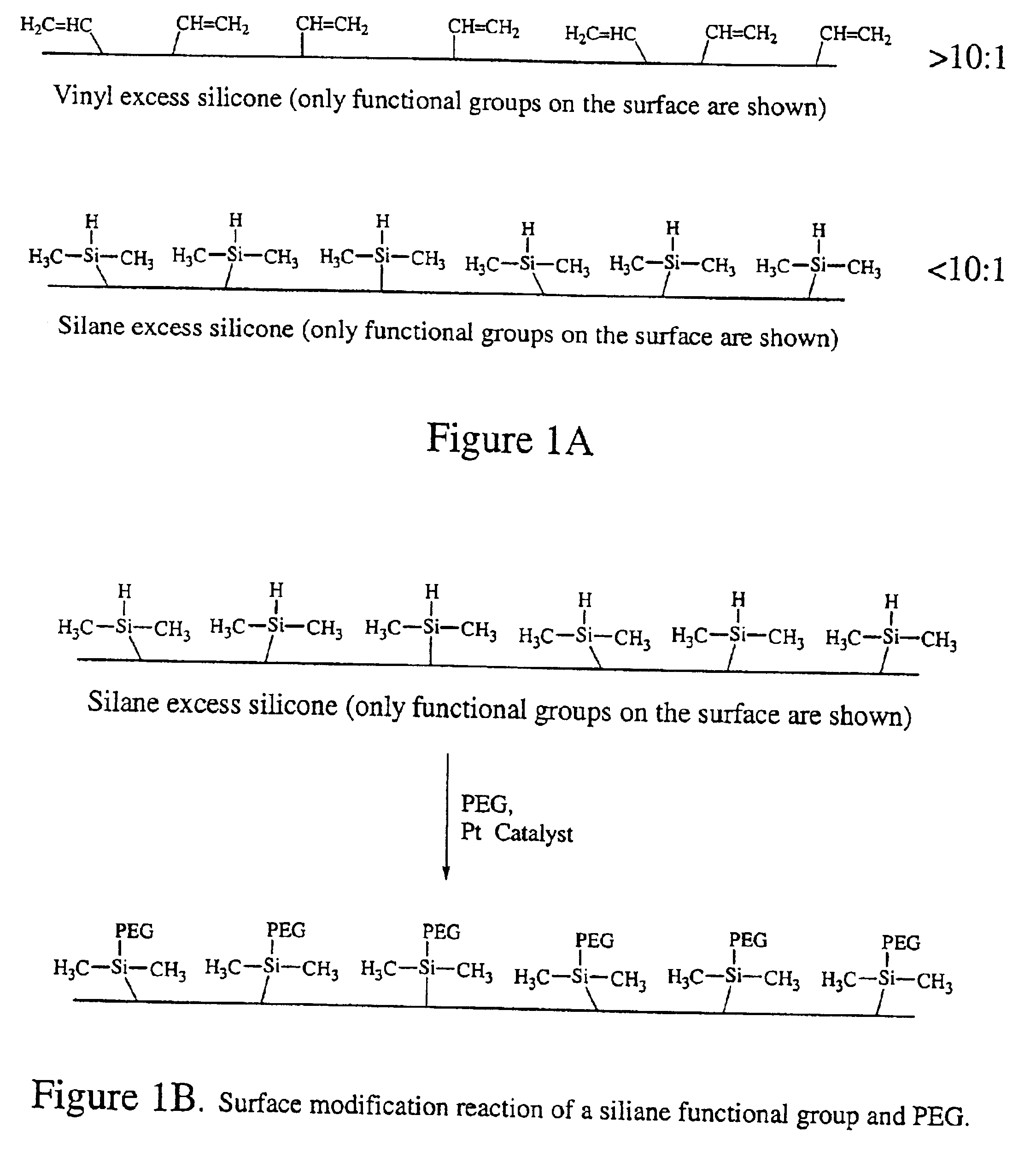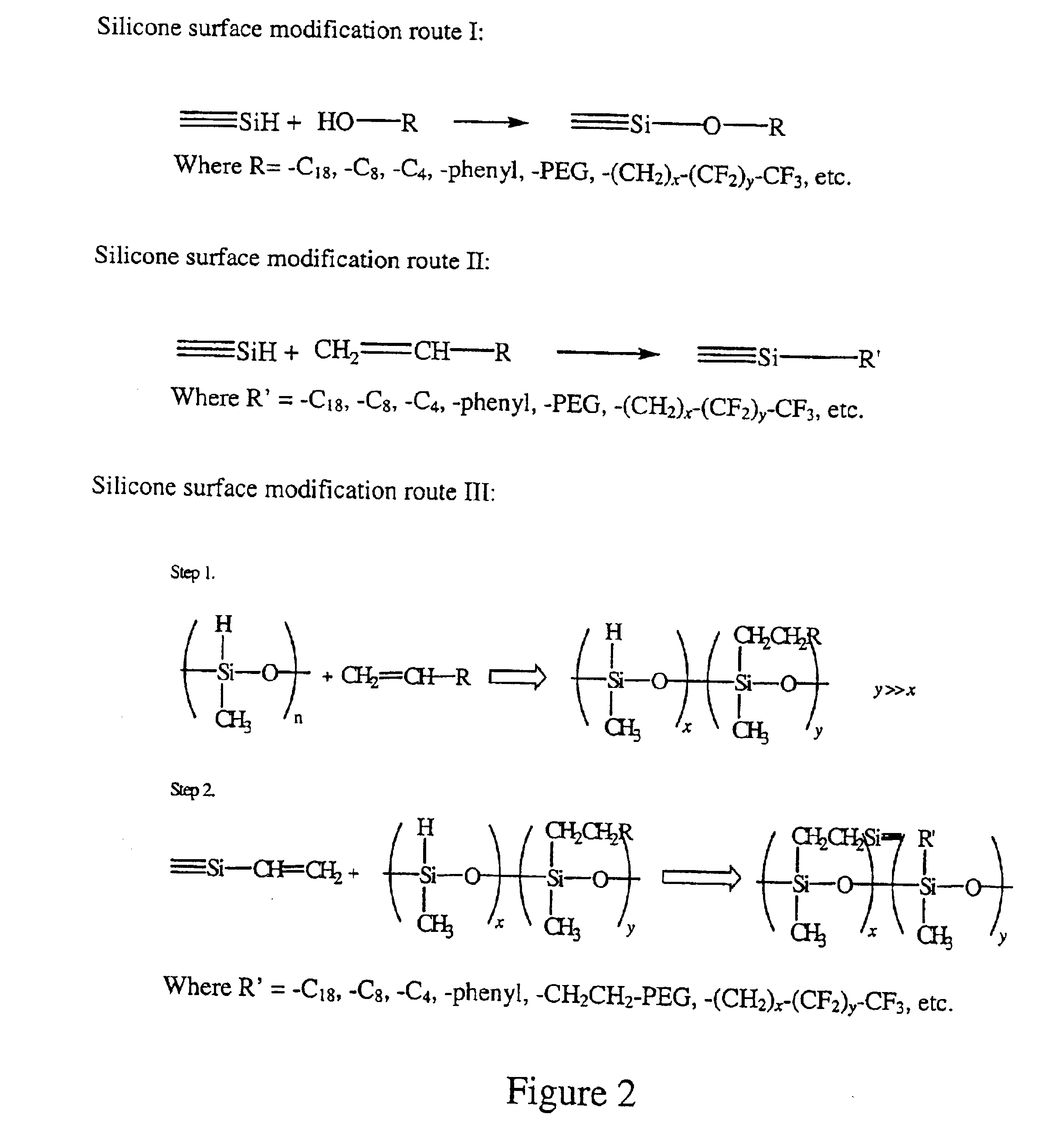Polymer surface modification
a polymer surface and polymer technology, applied in the direction of positive displacement liquid engine, flexible pipe, fluid speed measurement, etc., can solve the problems of significant changes in reagent concentration, carryover contamination, and incompatibility of many polymer materials with a variety of reagents
- Summary
- Abstract
- Description
- Claims
- Application Information
AI Technical Summary
Benefits of technology
Problems solved by technology
Method used
Image
Examples
example 1
[0191]A 3:1 (A:B) GE RTV 615 silicone mixture was cured at 80° C. in a convection oven for 3 hrs. The silicone sample was then immersed in a molten PEG sample (molecular weight 1,000, Polysciences, Inc.) at 80° C. for 24 hrs. The surface treated samples were then repeatedly washed with high purity deionized (i.e., DI) water for 2 hrs. The resulting samples were incubated with conjugated protein solutions for 2 hrs at room temperature. The protein solutions used were: insulin-FITC (1 mg / mL), BSA-FITC (1 mg / mL), IgG-FITC (1 mg / mL) and Strepdavidin-Cy3 (0.2 mg / mL). The PEG grafted silicone samples were then washed with DI water gently three times. Fluorescence microscope was used to record the fluorescence intensity of the samples. The settings of the microscope were at such that the intensity is linearly proportional to the amount of the residue protein on the surface. As shown in FIG. 25, results indicate that the PEG treated surface reduces the adsorption of proteins from 95% (insul...
example 2
[0192]A 4:1 GE RTV silicone mixture was cured at 80° C. in a convection oven for 3 hrs. The excess hydrosilane groups from RTV 615B on the surface were utilized for polyethylene glycol grafting. An allyl-derived PEG, polyoxyethylene mono-allylether CH2═CHCH2O(CH2CH2O)16—H (AG-160) from Kowa was used for surface grafting. Platinum chloride catalyst, H2PtCl6 (Sigma-Aldrich), was used to catalyze the hydrosilylation reaction. The catalyst concentration used was in the range of 100˜1000 ppm (weight %) and the reaction time at 80° C. ranged from several minutes to hours, depending on the catalyst concentration. As expected, the higher the catalyst concentration, the shorter the reaction time was needed to achieve a desired degree of reaction. The molten AG-160 was used to carry out the reactions. The samples were then washed thoroughly with methanol and DI water in ultrasonic batch. The samples were then dried at 80° C. for 2 hrs. After the cleaning and drying, the top ˜1 μm of the PDMS ...
example 3
[0194]A 4:1 GE RTV 615 silicone mixture was cured at 80° C. in a convection oven for 3 hrs. The excess hydrosilane groups from RTV 615B on the surface were utilized for polyethylene glycol grafting. Allyl-derived PEG, polyoxyethylene mono-allylether CH2═CHCH2O(CH2CH2O)16—H (AG-160) from Kowa was used for surface grafting. The catalyst concentration is in the range of 100-1000 ppm (weight %) and the reaction time at 80° C. was from several minutes to several hours. Aqueous AG-160 solution (10 wt % of AG-160) was used to carry out the grafting reactions. FIG. 28 is an ATR-FTIR spectra of the PDMS samples with PEG grafting reactions carried out in water solution. The reaction trend is very similar to that of Example 1, but higher intensity of hydroxyl groups was observed at around 3400 cm−1. This may indicate the hydrolysis of surface siloxane groups.
PUM
| Property | Measurement | Unit |
|---|---|---|
| width | aaaaa | aaaaa |
| Young's modulus | aaaaa | aaaaa |
| Young's modulus | aaaaa | aaaaa |
Abstract
Description
Claims
Application Information
 Login to View More
Login to View More - R&D
- Intellectual Property
- Life Sciences
- Materials
- Tech Scout
- Unparalleled Data Quality
- Higher Quality Content
- 60% Fewer Hallucinations
Browse by: Latest US Patents, China's latest patents, Technical Efficacy Thesaurus, Application Domain, Technology Topic, Popular Technical Reports.
© 2025 PatSnap. All rights reserved.Legal|Privacy policy|Modern Slavery Act Transparency Statement|Sitemap|About US| Contact US: help@patsnap.com



